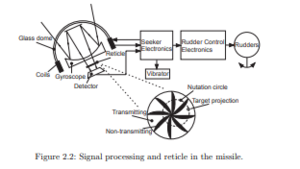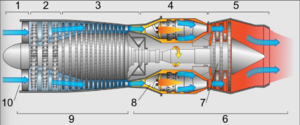Basic Limitations of the AIM-9B Missile against a Non-Maneuvering Target -- Range
IR Pattern
The missile gyro-seeker locks onto the strongest point-source of IR radiation. For a target in military power, the strongest point-source is the hot metal of the jet’s tailpipe. Approximately 85% of the IR signal generated comes from this hot metal and the remaining 15% comes from the hot jet exhaust. For a target operating in afterburner, the primary source of radiation is the hot exhaust flame. Approximately 60% of the signal generated comes from flame and 40% is generated by the hot metal of the tailpipe. In the discussion of radiation patterns, it is necessary to keep in mind the shape of the pattern. In aircraft with shielded tailpipes, radiation patterns are generally long and relatively narrow; whereas, in aircraft which do not have shielded tailpipes, the patterns are long and wide. In fighter -type aircraft, the radiation pattern is generally long and relatively narrow since the geometry of the aircraft shields the tailpipe. This applies in military power only. In afterburner power, naturally, the pattern is long and wide, since the flame of the afterburner is not shielded by the jet’s aft fuselage. In both English and Soviet bomber-type airplanes, in the horizontal plane, the jet tailpipe is shielded by the sweep-back of the wings, thus presenting a long narrow pattern. In the vertical plane, however, the pattern is long and wide, since the wings do not shield the hot metal and the jet exhaust. USAF bomber-type aircraft, on the other hand, present long and wide horizontal patterns, since the engine nacelles are suspended below the wing, providing the gyro-seeker a relatively unrestricted view of the jet exhaust. In the overhead vertical plane, the pattern is long and narrow, since the wing shields the IR radiation from the gyro-seeker. Radiation patterns vary with tailpipe temperature as well as with area of the source. In other words, the greater the temperature, the greater the radiation pattern; and, logically, the larger the source, the greater the radiation pattern. To illustrate: A bomber with 8 engines in military power, as compared to a fighter with one engine in military power, would generate a much larger radiation pattern because the area of the source is much greater.
Background IR sources are significant factors affecting the size and shape of radiation patterns. Important background IR sources are (1) Sun, (2) Clouds, (3) Water, (4) Snow and (5) Terrain.
(1) Sun: The sun is the strongest source of infra-red energy known. You cannot fire Sidewinder at targets flying directly between you and the sun, since the sun’s radiation will decoy the missile away from the target. Therefore, do not fire at a target which is within 25° of the sun. Also, do not continuously point the missile directly at the sun for more than ten seconds, or the lead sulphide detector may be permanently damaged.
(2) Clouds: Clouds reflect IR radiation from the sun – particularly cumulus clouds. If you must fire at a target which is framed against a bright cloud background, in all probability you will be forced to reduce your slant range to 6,000 or 8,000 feet (AFMDC ADJ SS-845) to obtain proper signal discrimination. If the target is hidden by clouds, the clouds will confuse the target signal so that the missile will not home. The signal which you receive will be the background radiation reflected by the clouds. A good rule of-thumb for flying in clouds or against a cloud background is: diminish range until it is possible to discriminate between the background and the target signal.
(3) Water: Water, like clouds, reflects IR energy from the sun. Calm water is a tremendous background radiator when the sun’s images can actually be seen in the water. Rough or choppy water, on the other hand, reflects IR radiation in all directions and the attacker need not be in a position where he can see the image of the sun on the water. As when operating against a cloud background, diminish range until you can achieve proper signal discrimination.
(4) Snow: Snow, like water and clouds, reflects the sun’s IR energy. When firing against a snow background, as compared to a water or cloud background, you will have to diminish your slant range much more in order to get proper signal discrimination. There is a good possibility that you will be forced inside the missile’s minimum range, thereby precluding a missile attack.
(5) Terrain: Terrain background reduces maximum missile range, as do clouds and other previously mentioned backgrounds. Light terrain in particular, such as dry lakes and sand, provides maximum background radiation. When firing against the three previously mentioned backgrounds, under an overcast, max range is not diminished nearly as much as when firing under CAVU conditions, since the clouds act as a device for shielding out the sun’s IR radiation.
Basic Limitations of the AIM-9B Missile against a Non-Maneuvering Target -- Range

